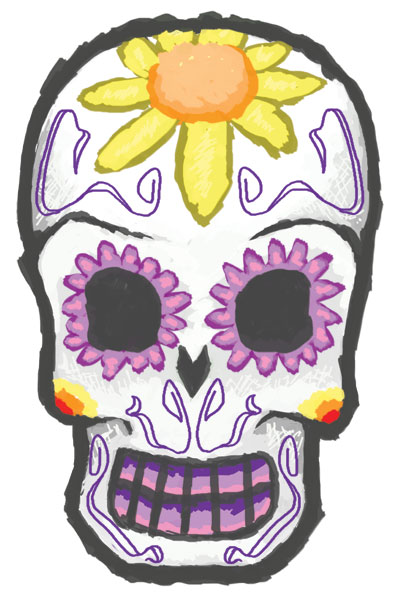
Spanish Club Celebrates Los Días de los Muertos
Once Halloween is over in the U.S., the Days of the Dead celebrations, November 1-2, start all over in the country of Mexico. Families gather in cemeteries to hold candlelight vigils for the dead, celebrating their loved ones, their family members and friends, who have passed on.
The Spanish Club, after learning in class about the holiday, held their own celebration Thursday, Nov. 3 to experience some of this culture. Students built a commemorative altar and enjoyed Hispanic foods in a holiday that is often mis-understood by others.
The Days of the Dead celebrations can be traced back to the indigenous cultures of Mexico long before the Spaniards arrived, perhaps as far back as 3000 years. In the pre-Hispanic era, it was common for indigenous people to keep skulls as trophies and display them during their rituals as symbols of death and rebirth. The festival that became the modern Day of the Dead fell in the ninth month of the Aztec calendar, about the beginning of August, and was celebrated for an entire month.
The holiday is now celebrated over two days in November when it is said that the souls of the dead will visit loved ones in the wee hours of November 2.
In most regions of Mexico, November 1 is set aside to honor deceased children and infants; deceased adults are honored on November 2. This is indicated by generally referring to November 1 as Día de los Inocentes ("Day of the Innocents") or Día de los Angelitos ("Day of the Little Angels") and November 2 as Día de los Muertos or Día de los Difuntos ("Day of the Dead”).
The holiday is not for mourning; it is considered a time of celebration and a time to recognize that death is the ultimate common denominator.
The altars that honor the dead are the most important part of the festivities. This pre-Hispanic tradition has become an integrated part of the Catholic religion in Mexico.
To be authentic, the altar should have a photograph of the person whom the altar is dedicated to and “papel picado” (bright colored tissue paper). Purple tissue is for pain, white is for hope, and pink is for the celebration.
Other things that can be found on a traditional altar are candles at the four cardinal points (to illuminate the way for the dead upon their return), three candy skulls (the larger skull represents the Giver of Life) and a small cross of ash (so that the ghost can expel all its guilt by stepping through the ash). The Day of the Dead bread, “pan de muerto,” is also placed on the altar, accompanied by fruit and candy.
Many altars also display a towel, soap and a small bowl of water so that returning ghosts can wash their hands after their long trip, and water to quench their thirst (or a bottle of liquor to remember the good times of their life).
The final touch to decorate the altar is the traditional “cempasuchil” flower, a marigold. Marigolds are fabled to have four hundred lives, and they are placed to form a path to bring the spirits to their banquet.
An interesting note is that Hispanic families will often spend the holiday picnicking with their altar atop the grave site of a loved one to celebrate that loved one’s life while we in “los Estados Unidos” find it disrespectful to even put our feet on a loved one’s grave.
Spanish Club secretary Renee Vara says, “This event was very exciting. The primary focus is to increase public awareness and give people an opportunity to speak Spanish on a regular basis.”
Vara is also excited about the club this year. “We are just getting started; I think we are off to a good start. There is a very wide range of Spanish speaking levels.”
President Amber Vincent states, “We hope to hold future events to increase public awareness of the World Language Association and to remind students of the upcoming ‘Viva Mexico,’ a documentary of Mexico and its current relevance in the global scheme.”
The club is hoping to do an event for “Cinco de Mayo” as well as other activities throughout the school year. The Spanish Club meets every Thursday “a la tres de la tarde” (3:00 p.m.).
| The Mainstream is a student publication of Umpqua Community College. | About us | Advertising | Archives |
